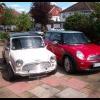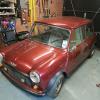May 1982
Although we didn’t know it at the time, the future of MG would be tied-up with BL’s shiny new supermini. The story of the Metro is a fascinating one, not only because the car’s ability and success far exceeded the sum of its parts, but also because it had been the final flowering of several Mini replacement programmes that had been in train since the late 1960s. It relied heavily on existing parts, such as the Mini’s drivetrain and a simplified version of the Allegro’s suspension system. It was to be built by state-of-the art robots in Longbridge, swallowed £275m of investment, leading Michael Edwardes’ much-vaunted ‘product-led recovery’ for BL.
Even before the ink had dried on the Metro’s launch brochures and the customers had placed their first orders, BL was investigating how to build a faster version. First there was the intriguing Metro Plus – a go-faster Metro built by BL Motorsport in Abingdon – which ended up becoming the Wood & Pickett Metro Plus after the idea was canned in favour of something a little more commercially appealing.
However, from that programme, a modified cylinder head and carburettor was developed to tease out a Mini-Cooper S-matching 72bhp. Although it wasn’t obvious to industry watchers at the time, there was never any doubt that this would take the form of an MG Metro.
Harold Musgrove confirms this: ‘We never gave a thought to using the Cooper name. Why pay John Cooper royalties when we had MG to use? In hindsight, a Cooper S might have made more sense, but Austin Rover was weak on marketing, and I had no marketing experience.’
Metro Cooper rattles BL’s cage
John Cooper thinking the same way, and in 1981 announced the Metro Cooper – a Janspeed-tuned version with 80bhp and Wolfrace alloys that looked remarkably like the MG Metro. It was planned at the rate of 10 per week and to be sold through the Wadham Stringer dealer network.
But BL asked Cooper to rename it after threatening Wadham Stringer that it would not offer a factory warranty on the car. So, it became the Metro Monaco, and as John Cooper recalled at the time: ‘I wish they’d told me sooner – that would have made things a lot easier for Jan Odor, for me, for everyone…’
By this point, the UK had been gripped by Metromania. You couldn’t move for aftermarket-converted Metros. It even had the Royal seal of approval thanks to Lady Diana’s high-profile ownership. And it was into this climate that in May 1982 that Austin Rover rolled out the first production MG since the closure of Abingdon, and one which perfectly encapsulated the brand values of its maker. It was much needed, looked good and as the adverts proclaimed: ‘Your best friend will hate you’!
More of the MG Metro Story on AROnline here:-
https://www.aronline...ss-to/mg-metro/
Edited by mab01uk, 11 May 2022 - 07:21 AM.















